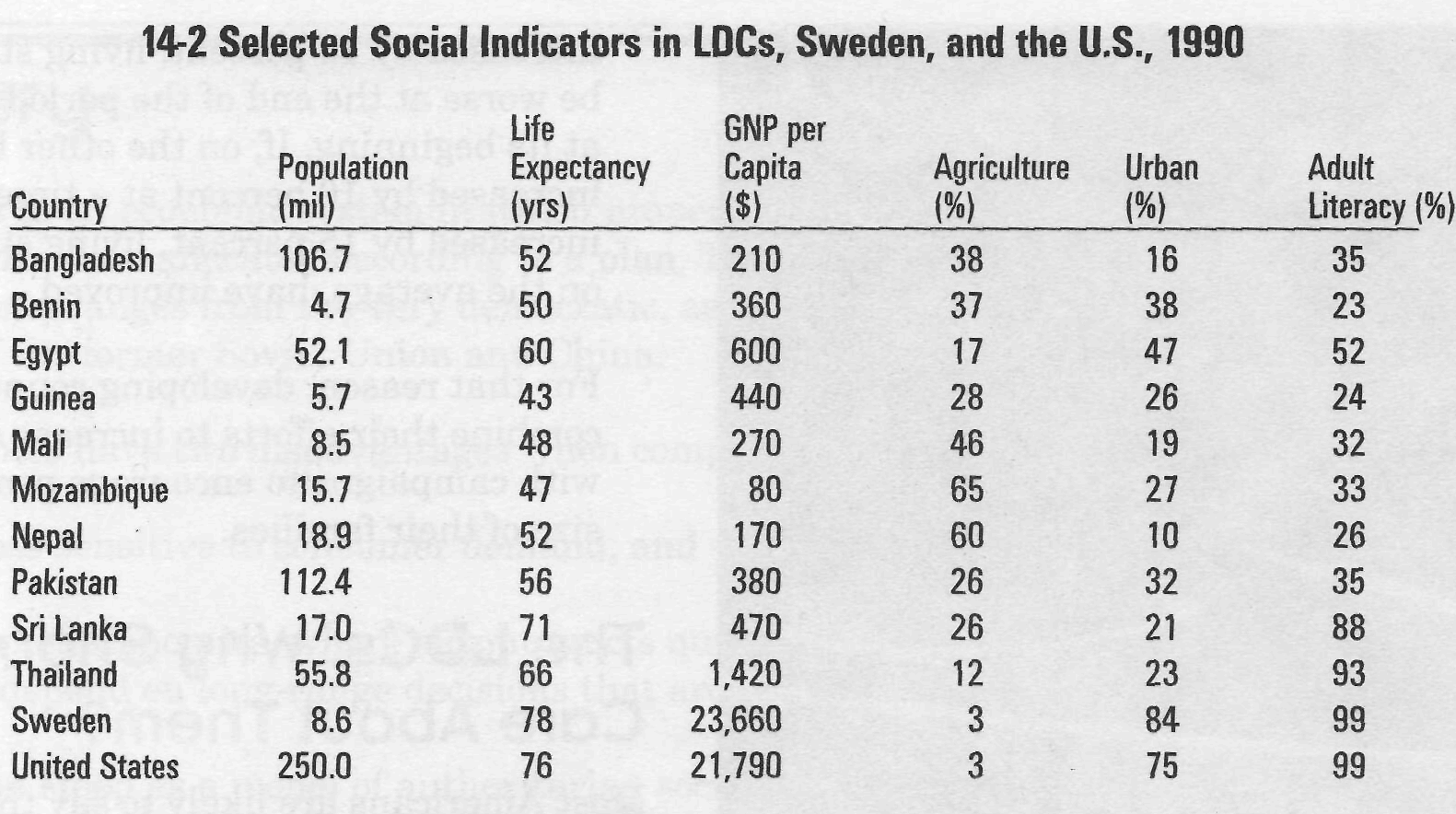
- •14.1. Socialism
- •14.2. Communism in the u.S.S.R.
- •14.3. Hungary: Communism with a Dose of Market System
- •14.4. Sweden: Democratic Socialism in a Capitalist Setting
- •14.5. Capitalism and Free Enterprise in Japan
- •14.6. The Less-Developed Countries (ldCs)
- •14.7. The Special Problems of the ldCs
- •14.8. Economic Growth: the Way out for Most ldCs
- •14.9. Economic Development in Action
- •14.10. The ldCs: Why Should We Care about Them?
14.7. The Special Problems of the ldCs
The LDCs can be found just about everywhere except in North America and Europe. All the nations of Africa, with the exception of Libya and South Africa, are LDCs. So, too, are half the nations of South America, all of those in Central America and most of those in Asia. It is difficult to generalize about so many different countries and cultures but the LDCs do share most of the following problems
The Legacy of Colonialism. In the years before World War II, most of the LDCs were colonies of the industrialized nations or were dominated by them As a result they were heavily influenced by foreign economies which may not have had their best long-term interests at heart. Some claim that the removal of raw materials and resources from the colonies long ago weakens them today.
Low Productive Capacity. In a year when the United States economy produced about $22,000 for each of its citizens, the Asian nation of Pakistan had a per capita GNP of $380. Other LDCs had similar records. (See Table 14-2.)
An Inadequate Resource Base. Perhaps the main reason why the LDCs produce so little is that they have few resources. They are commonly short of productive capital (machines, tools, and factories). Their infrastructures (roads, harbors, utilities, and water supplies) are usually inadequate to meet their needs.
Most serious, perhaps, is a lack of what economists call "human capital." By this they mean that the people of less-developed countries lack the skills needed to develop their economies. There are high rates of illiteracy, poor health conditions, and shortages of managerial personnel. (See Table 14-2.)
The Vicious Circle. The problems facing the LDCs feed on one another in what is sometimes described as a "vicious circle of poverty." Because incomes in the LDCs are very low, people need every penny they earn just to meet their most basic needs. There is little left for savings. But when there are no savings, there is little capital investment in new factories, machines, and technology.
When there is little capital investment, productivity will be low because workers lack modern equipment. Low productivity leads to low incomes, which brings us back to where we started.
14.8. Economic Growth: the Way out for Most ldCs
Clearly, the solution to the problems of poverty suffered by the less-developed nations lies in increasing their ability to produce goods and services and to deliver them to their people. In other words, what is needed is a substantial amount of economic growth.
What Is Economic Growth? Economic growth may be defined as a steady increase in an economy's ability to produce. One good measure of economic growth is real per capita GNP or GDP. This, you will recall, is calculated by dividing the GNP or GDP, expressed in constant dollars by the population. To promote economic growth, a nation needs to be able to invest in improving its productive resources. Where do the resources for improvement come from?
• Savings and investment. If a country consumes everything it produces, the ability of that country to produce more in the future will remain unchanged. If, however, something is set aside out of current production, it could be used as capital to produce more in the future.
• Foreign investment as a source of capital.
Not all capital must come from savings. It is possible for less-developed countries to borrow needed funds from more-developed countries or to permit foreign investors to establish business operations within their borders. Foreign investment may come from either private or government sources.
But help from foreign sources can lead to other problems for the LDCs. Sometimes outsiders have used their assistance as a way to impose their form of government on the less-developed countries or to exploit the countries by taking much more out of them than they put in.

• The international economic agencies. To
avoid some of these problems and to help the LDCs achieve more stable economic conditions, several international agencies were created.
- One such agency is the World Bank. The World Bank (or International Bank for Reconstruction and Development) makes long-term loans to LDCs to stimulate economic growth.
- The World Bank also operates the International Development Agency (IDA). The IDA makes very long-term loans to the poorest of nations, which need extra time to repay.
- The International Monetary Fund (IMF)
assists the LDCs by offeringthem short-term loans of foreign exchange.
- The International Finance Corporation
(IFC) provides capital and managerial assistance to private businesses in the less-developed countries.
